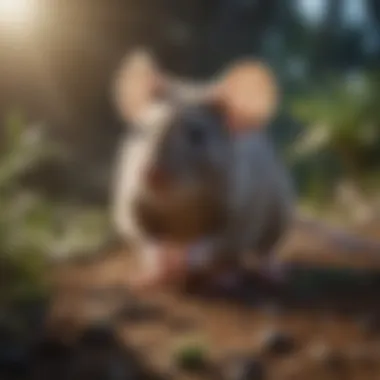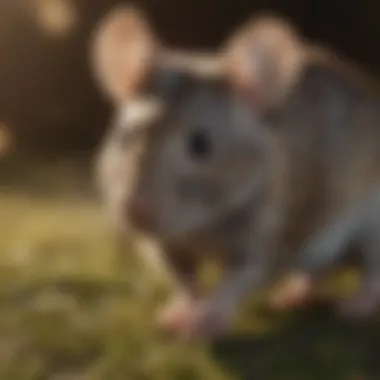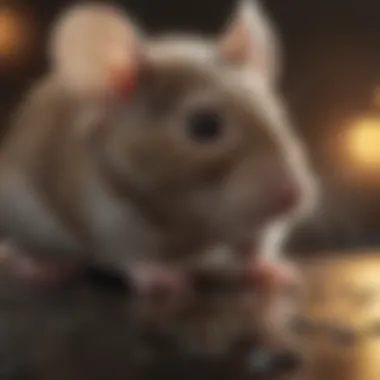Understanding the Challenges in Catching Mice: An In-depth Analysis


Intro
Catching mice often proves to be a perplexing task. Understanding their uncanny traits and behaviors is crucial for devising effective methods of capture. Despite their small size, mice possess a remarkable ability to evade traps and other strategies employed by humans. This article aims to explore the intricacies of catching these elusive creatures and why common approaches may falter. By intertwining the knowledge of mouse behavior, habitat, and humane strategies, a clearer picture emerges on how to manage this widespread issue.
Fascinating Facts About the Animal
Unique Characteristics
Mice, particularly the Mus musculus, are the most common species encountered in human habitats. These creatures exhibit several unique characteristics. For instance, their keen sense of smell plays a pivotal role in their survival. Mice can detect odors in parts per billion, a feature that assists them in locating food and avoiding danger. They also have highly developed hearing, which allows them to sense predators even from a distance. Additionally, their small size provides them agility to navigate tight spaces, making them hard to catch.
Extraordinary Abilities
Beyond their senses, mice are capable of astonishing feats. They can jump about 12 inches vertically and can run at speeds of up to 8 miles per hour. Furthermore, the adaptability of mice to various environments contributes significantly to their survival. They can thrive in urban, rural, and natural settings, finding shelter in walls, attics, or underground burrows. This adaptability complicates efforts to control their populations, as they easily evade traps and other methods intended to secure them.
Prologue to the Issue
Catching mice is a significant problem both domestically and in various industries. This article explores why this task can prove difficult. Understanding the reasons behind this challenge is crucial. It helps in developing effective strategies down the line. We find ourselves navigating behavioral traits of mice, which often appear evasive. Capturing them requires a nuanced approach that considers their instincts and environmental interactions.
Defining the Problem of Mouse Catching
The issue of mouse catching can seem straightforward, yet it involves complex dynamics. At the core, mice are very adaptable creatures. Their ability to reproduce swiftly compounds the issue. A small infestation can quickly escalate into much larger problems. Understanding the difficulty in mouse capture means recognizing their elusive nature. The anatomy of a mouse allows for quick escapes through tight spaces.
Moreover, humans sometimes overlook the fact that mice are nocturnal. They are active during the night, making detection challenging. As a result, conventional trapping methods may fail to yield results. Effectively defining the problem thus becomes imperative to finding a solution.
Importance of Understanding Mouse Behavior
Knowing mouse behavior is not merely beneficial; it is essential for successful mouse control. Mice tend to display a range of natural instincts. These instincts guide their actions and reactions to what they perceive as threats. For example, if they feel cornered, they may exhibit panic behaviors, complicating trapping efforts.
Additionally, studying their social structures reveals how groups interact. Social hierarchies among mice affect their feeding patterns and even their approach to conflict. By observing these behaviors, individuals can tailor trapping techniques accordingly. Recognizing that mice experience fear and curiosity also influences bait selection. Typically, well-informed strategies lead to better outcomes, while ignorance usually results in fruitless efforts.
Understanding these aspects ultimately leads to more effective pest control strategies. Analyzing these behaviors provides insights that enhance the chances of successful capture. As we proceed through this article, it becomes clear that addressing these challenges head-on will empower efforts in mouse management.
Mouse Behavior and Adaptability
Understanding the behavior and adaptability of mice is crucial for effective mouse management. These small rodents exhibit a range of behaviors that directly influence their catchability. Recognizing these behaviors allows for better strategies in trapping and pest control. Knowledge about mouse adaptability can lead to a more informed approach when addressing infestations. This section will explore various facets of mouse behavior, focusing on their natural instincts, the environmental influences on their actions, and their social structures.
Natural Instincts of Mice
Mice possess several natural instincts that play significant roles in their survival. They are prey animals, meaning that their behavior is heavily influenced by the need to avoid predators. This instinct leads to cautious exploration of new environments. Mice often exhibit behaviors such as hiding and burrowing, which serve as protective measures. They use their acute sense of smell and hearing to detect danger and locate food sources.
Moreover, mice are known for their nocturnal habits, being more active at night when it is safer from many predators. This active lifestyle contributes to their adaptability. They have a remarkable memory that allows them to navigate and recall paths to food and shelter. These instincts make it challenging to catch them since they can avoid traps and learn from previous encounters.
How Environment Influences Behavior
The environment significantly affects mouse behavior. Various factors, such as urbanization, availability of food, and even seasonal changes, influence how and where mice live. For instance, in urban settings, mice often find food in human refuse, leading to increased population densities in those areas. This availability of food alters their natural behaviors, making them more bold and willing to explore human habitats.
Seasonality plays a critical role as well. During colder months, mice seek warmer places, which often include attics and basements. These seasonal shifts require a better understanding of their patterns to develop specific capture strategies. Recognizing these environmental influences is integral when devising a plan for effective pest control, as it allows individuals to take advantage of their predictable behaviors during different times of the year.
Social Structures within Rodent Populations
Mice exist within complex social structures. They are social animals, often living in groups, which can complicate catching strategies. Social interactions can dictate behaviors such as competition for food and shelter, which are key to managing populations. Understanding these dynamics is essential, as a dominant mouse can control access to resources, affecting the entire group's behavior.
These social structures evolve based on environmental stressors. For example, overcrowding can lead to increased aggression and changes in reproductive patterns. A deeper understanding of these social interactions can aid in developing humane strategies for relocation or trapping. Observing how these social hierarchies function can inform which methods to employ in controlling mouse populations more effectively.


Understanding mouse behavior and adaptability is fundamental for both pest control strategies and the humane treatment of these animals.
To sum up, this section has analyzed the various components that shape mouse behavior and adaptability. Recognizing their natural instincts, environmental influences, and social structures is vital for anyone dealing with mouse populations. This insight helps in creating targeted interventions that respect both human needs and animal welfare.
Common Mistakes in Mouse Catching Techniques
Catching mice can often be a frustrating endeavor, and many individuals make common mistakes that hinder their success. Understanding these errors is crucial, as it can significantly impact the effectiveness of mouse catching techniques. By identifying these pitfalls, readers can equip themselves with the knowledge to improve their strategies. The following sections explore three prevalent mistakes: choosing the wrong tools, misunderstanding bait selection, and ignoring mouse territory.
Choosing the Wrong Tools
Selecting appropriate tools is fundamental in any pest control strategy. Many people turn to traps without considering their specific needs. Various traps are available, each designed for different circumstances. For example, using a snap trap may be suitable for larger infestations, while live traps might be better for those seeking humane options.
The failure to assess the situation can result in ineffective outcomes. A poorly chosen trap may not only fail to catch mice but could also create a false sense of security. Familiarizing yourself with the tools available ensures that the right solution is implemented from the start. Furthermore, engaging with local pest control experts can provide insights into which tools work better in specific environments.
Misunderstanding Bait Selection
The selection of bait plays a vital role in the success of mouse trapping. Mice are often drawn to certain scents, but many common choices are ineffective. Using peanut butter or cheese is a standard practice; however, it might not be the best approach for every situation.
Consider the following when selecting bait:
- Freshness: Stale or old bait can deter mice.
- Flavor Preferences: Different mice may have different preferences. Some might prefer seeds or grains instead of traditional options.
- Quantity: Overloading a trap with too much bait can lead to faster spoilage and increased chances of the mouse taking only part of the bait, leading to empty traps.
A thoughtful approach to bait selection can enhance trapping efforts, leading to more successful outcomes.
Ignoring Mouse Territory
Mice have established territories that are influenced by food availability, shelter, and social structures. Ignoring these territorial factors can lead to trapping failures. Understanding mouse behavior, such as their preferred pathways and nesting sites, is essential.
Some key points to consider include:
- Observation: Spend time observing mouse activity. Look for droppings or signs of nibbling in specific areas.
- Placement of Traps: Position traps along walls and pathways where mice frequently travel. Placing traps in open spaces may not be as effective.
- Respect Food Supply: If food sources are abundant, mice are less likely to venture near traps. Therefore, identifying and managing these food supplies is important.
By taking territory into account, one can tailor trapping strategies that align with natural mouse behaviors, leading to improved catch rates.
A successful mouse catching strategy encompasses the right tools, appropriate bait, and a solid understanding of mouse territories. When these factors align, the chances of successful trapping increase significantly.
The Effectiveness of Various Trapping Methods
The use of trapping methods is a critical aspect in the management of mouse infestations. Choosing the right trapping technique is fundamental for success. Different methods come with unique advantages and limitations, making understanding their effectiveness essential for both homeowners and pest control professionals. The choice often depends on various factors, including the urgency of the situation, ethical considerations, effectiveness, and the specific environment where the trapping will occur.
Traditional Traps
Traditional traps have been a staple in pest control for many years. These mechanisms typically use bait to lure mice into a confined space where they are then incapacitated. The simplicity of design is one of the reasons they remain popular. Key aspects include:
- Affordability: They are generally inexpensive and widely available.
- Effectiveness: When correctly positioned, they demonstrate high efficacy in catching mice.
- Ease of use: Setting up traditional traps typically requires minimal skill and can be done quickly.
However, they also present challenges. For instance, they can be a concern in terms of humaneness and often do not prevent the capture of non-target species. Many users may struggle with the placement in areas where mouse activity is high, leading to reduced effectiveness.
Live Catch Traps
Live catch traps provide an alternative that aligns with humane pest control approaches. These traps capture mice without causing harm, allowing for relocation. Their benefits include:
- Humaneness: They reduce suffering for the trapped animal.
- Non-lethal: Useful for those who prefer to avoid killing animals outright.


Nonetheless, these traps require users to check them frequently. If a trapped mouse is left unattended, it can suffer from stress or starvation. Additionally, understanding the correct locations for deployment can significantly impact their success rate. Factors like bait selection and trap sensitivity play crucial roles.
Electronic Traps
Electronic traps are a modern solution in the fight against mouse infestation. These devices utilize technology to deliver a swift and efficient method for trapping mice. Important points to consider include:
- Speed and efficiency: They often kill mice instantly, which may be seen as a more humane method by some.
- Clean operation: Many electronic traps can be disposed of easily, reducing the mess typically associated with traditional traps.
- Monitoring capability: Certain models come with app connectivity, enabling monitoring of trap status remotely.
Yet, while electronic traps show promise, they require a power source and may incur higher initial costs. Their effectiveness can be compromised in areas prone to moisture, where electrical components may fail.
When selecting a trapping method, it is crucial to weigh the ethical implications alongside the practicality and effectiveness of each option.
Technological Innovations in Pest Control
Technological advancements in pest control reflect a significant shift in how we approach the challenge of catching mice. These innovations not only provide effective solutions but also enhance our understanding of mouse behavior and ecology. The integration of technology in pest control strategies marks an important evolution, providing both efficiency and precision in managing rodent populations.
Smart Traps and Sensors
Smart traps and sensors exemplify the intersection of technology and pest management. These traps are equipped with sensors that can detect the presence of mice, enabling immediate action. They can send real-time alerts to users, indicating when a mouse has entered the trap. This reduces the time a rodent could potentially roam free, which can otherwise lead to further infestations.
Some key benefits of smart traps include:
- Real-time monitoring: Catching mice becomes more efficient with the immediate notifications provided by these traps.
- Data collection: Many smart traps also collect data on mouse activity, helping to identify patterns that can inform future pest control strategies.
- User-friendly interface: Most systems allow users to manage their traps through a smartphone application, making it easier to stay connected and informed.
However, there are considerations to keep in mind. The initial cost of smart traps can be higher than traditional methods. Moreover, reliance on technology can sometimes lead to neglect in regular inspections of traps, which remain essential for effective management.
Use of Artificial Intelligence
Artificial Intelligence (AI) is increasingly becoming a vital tool in understanding and managing mouse populations. By analyzing data collected from traps and sensors, AI can identify patterns in mouse behavior and predict where infestations may occur.
Key Aspects of AI in Pest Control:
- Predictive analytics: AI algorithms can analyze environmental data and mouse activity to forecast potential future infestations, allowing for preemptive measures.
- Adaptive strategies: AI systems can learn from past data, adjusting pest control methods based on what has been most effective in specific circumstances.
- Resource optimization: By enabling more efficient resource allocation, AI can ensure that measures are only implemented where and when they are needed.
The application of AI brings myriad benefits but also raises questions regarding privacy and data security. It is essential to have clear regulations to protect user information while leveraging technology to its full potential.
In summary, technological innovations like smart traps and the use of artificial intelligence are revolutionizing how we address rodent challenges. These advancements not only enhance the efficacy of pest control methods but also promote sustainability and informed decision-making in managing mouse populations.
Understanding Environmental Influences
Understanding the environmental influences on mice populations is crucial for effective management strategies. Various factors, such as seasonality and food availability, play significant roles in mouse behavior and movement patterns. Recognizing these influences aids in tailoring pest control methods that are both effective and humane.
Role of Seasonality in Mouse Activity
Seasonal changes significantly affect the behavior of mice. During colder months, they seek shelter and warmth, often invading human structures. Understanding these patterns helps anticipate infestations before they occur. In winter, mice require more energy and food, prompting them to explore human habitats for sustenance.
Moreover, seasonal breeding patterns also contribute to population fluctuations. Mice tend to breed more in warmer months, leading to increased numbers in late spring and summer. This seasonality can influence the timing of trapping efforts, making it essential to implement control measures during peak activity periods. Correctly aligning trapping strategies with these seasonal trends can improve success rates.
Impact of Food Sources on Mouse Populations
Food sources are a primary driver of mouse populations. Mice are opportunistic feeders and will exploit various dietary options depending on availability. The presence of food in residential areas, such as pet food, unsecured garbage, or even garden plants, can attract mice and subsequently increase their numbers. Identifying and eliminating these food sources is a crucial step in controlling mouse populations effectively.
In urban environments, food scarcity can push mice toward human habitats. By understanding the impact of these food sources, homeowners can implement preventative measures. For instance, securing trash in sealed containers and removing potential food supplies can reduce the likelihood of mice invasion. Recognizing these patterns allows for a proactive approach in managing mouse populations.


Effective control of mouse populations requires a fundamental understanding of the environmental factors that shape their behavior. Addressing these influences can simplify capture strategies and reduce incidents of infestations.
Overall, grasping the dynamics between seasonality and food supply equips both families and pest control specialists with the knowledge necessary to manage mouse populations successfully.
Humane Alternatives to Mouse Trapping
Humane alternatives to mouse trapping are essential in managing rodent populations without causing harm to the animals. This approach not only aligns with ethical standards but also considers ecologically sustainable practices. It is vital to address the plight of these creatures while still ensuring that human habitats remain mouse-free. Understanding humane options and their effectiveness can reform how we view pest control, leading to better outcomes for both humans and wildlife.
Relocation Strategies
When considering relocation as a humane strategy, several factors must be taken into account. First, the choice of location for relocation is crucial. Released mice should be taken far enough away from the original location to prevent them from returning. A suitable area with adequate food and shelter is necessary to ensure their survival.
Key steps to effective relocation include:
- Selecting Proper Locations: Choose an area that is remote from human dwellings to avoid future conflicts.
- Monitoring the Release Site: Observing the area after relocation helps assess the environmental impact and whether the new location supports a healthy population.
It is important to note that relocating mice may not always be legally permissible in some areas. Local regulations should be reviewed to avoid potential legal issues. Moreover, mice that are relocated may also struggle to adapt to new environments, which can contribute to a high mortality rate for those animals.
Preventative Measures to Reduce Influx
To prevent future infestations, families and businesses should adopt preventative measures that target the root causes of rodent attraction. Effective strategies include:
- Proper Food Storage: Keep food in sealed containers. Remove potential food sources that attract mice. For example, pet food should not be left out overnight.
- Maintain Clean Environments: Regularly clean areas where food is consumed. Dispose of waste responsibly to reduce odors that attract mice.
- Seal Entry Points: Inspect buildings for holes or gaps. Use materials like steel wool or silicone to cover these entry points.
- Outdoor Maintenance: Keep vegetation well-trimmed and manage compost piles to minimize habitats near home that could shelter mice.
Taking these preventative measures significantly decreases the likelihood of a mouse infestation. By creating an unwelcoming environment, individuals and communities can coexist more harmoniously with wildlife, reducing the need for relocation or trapping altogether.
Preparing for Future Mouse Infestations
Dealing with mouse infestations is a persistent challenge. Preparedness plays a crucial role in minimizing the impact of future mouse problems. Recognizing the possibility of re-infestation is essential for individuals and communities alike. By focusing on prevention, we can significantly reduce the chances of mice becoming a nuisance.
Strategies for Long-Term Management
Long-term management of mouse populations requires a multi-faceted approach. Here are some effective strategies:
- Regular Inspections: Routine checks create awareness about potential infestations before they become severe. Inspect areas like basements, attics, and kitchens.
- Sealing Entry Points: Mice can enter through very small openings. It is important to seal gaps in buildings and homes. Use materials like steel wool or caulking agents.
- Sanitation: Ensuring that living spaces are clean reduces attractants for mice. This includes managing food waste and keeping storage areas organized.
- Sustainable Practices: Increasing general awareness about local ecology, including the role of predators, may help keep mouse populations in check over time.
By implementing these strategies, households can significantly reduce the likelihood of future infestations.
Community Approaches to Pest Control
Community collaboration is vital in addressing mouse control effectively. Initiatives can focus on shared resources and collective actions. Some approaches include:
- Education Campaigns: Raising awareness about mouse behavior, prevention tactics, and responsible pest management practices enhances community knowledge and cohesion.
- Neighborhood Clean-Up Days: Organizing regular clean-up events helps eliminate food sources for mice. These can create safer and cleaner environments for everyone.
- Communication with Pest Control Services: Engaging local pest control professionals for group rates or community workshops provides valuable insights and resources to everyone.
- Shared Resources: Communities can benefit from shared tools for pest control, like traps or deterrents. This not only saves cost but also encourages participation.
Ending: A Holistic Approach to Mouse Management
Addressing the challenges of catching mice requires a multidimensional strategy. This article illustrates that effective mouse management is not merely about setting traps or using poison. It is about incorporating various elements that consider mouse behavior, environmental factors, and humane practices. A holistic approach emphasizes the need for understanding each factor and how they interconnect.
Summarizing Key Insights
The previous sections emphasize several critical insights into mouse management. First, it is essential to grasp the natural instincts of mice and how these traits impact their reaction to traps. Mice are clever animals; they learn quickly and adapt to traps that they see often. Understanding these behaviors is crucial for selecting effective trapping methods.
Additionally, the environmental context cannot be ignored. Factors like food sources and seasonality heavily influence mouse populations. For instance, in autumn, mice seek shelter and food, making them more likely to invade homes. Thus, strategically addressing these opportunities can reduce the likelihood of infestations.
Moreover, humane alternatives—like relocation strategies—offer ways to manage mouse populations without resorting to killing them. This aspect is gaining increased recognition among the public, especially among families that prefer humane treatment towards animals.
Encouraging Ongoing Research
The landscape of pest control is continually evolving. As scientists discover more about the biology and behavior of mice, pest control strategies must also advance. Ongoing research in this area can lead to innovative solutions, including the use of technology and AI in traps. This can enhance efficiency and effectiveness, making it possible to catch mice while considering their welfare.
Encouraging community involvement in pest management creates a more significant impact. Educating families and communities about preventive measures fosters a shared responsibility. When people understand how to make their homes less inviting to mice, it can significantly lower populations over time.







